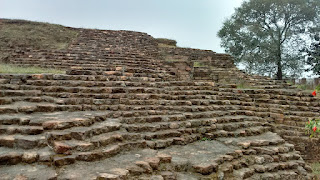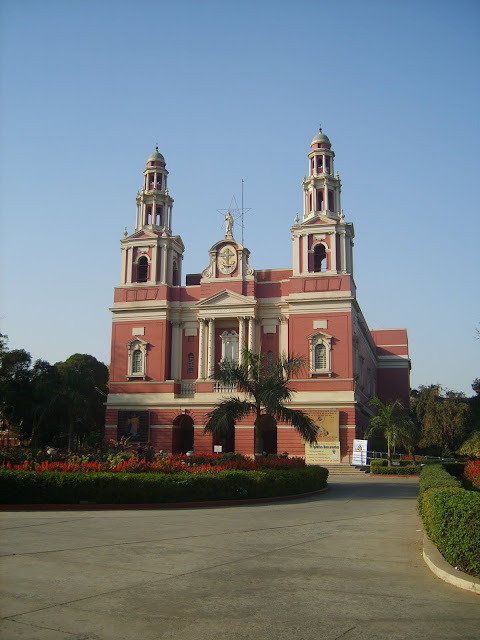Indians
take history for granted since perhaps they have a surfeit of it. New Delhi,
started as a showpiece of the British Empire, is itself nearing a century. A
trip to Delhi University inevitably takes one past the Old Fort and the Red
Fort, both hundreds of years old. But rarely does one stop to think about their
builders or the role that they played in making the past that brought us where
we are now. The sceptic asks, how does the ‘dead past’ matter now? If Shahjahan
built the Red Fort, in the 17th century, what of it? Today’s
builders (who are in trouble these days due to a slump in realty) are much more
relevant to us because we buy and live in the houses that they build.
My
response to those asking this question is: why is Hitler’s holocaust kept alive
to this day though more than 70 years have passed since it happened? None of
the people who committed the atrocities are alive any more so why not forget
and forgive? The Vietnamese say that while they have forgiven they have not
forgotten and they keep alive in museums memories of their sufferings of
decades ago when they became victims in a clash of ideologies during the Cold
War. Why is the anniversary of Second World War, the most destructive war in
history is observed every year though a good 70 years have passed since it came
to an end? The simple answer is that these events help us to locate ourselves in
the present. A quarter of a century has passed has gone by under the looming
shadow of economic liberalization and phenomenal growth in India. For those it
has touched but slightly it sometimes looks like a curse. But can we understand
what’s happening without knowing that the Cold War was a barrier to
globalization? And going back a little, can we explain the Cold War without
knowing about the Second World War. The single-word answer is ‘NO’.
THE CHINESE PUZZLE
To
return to the mystery of the Chinese and India’s lost past, let me begin by
saying that much of India’s ‘historical’ as against ‘mythological’ past was
discovered and recorded in the 19th and 20th centuries. As
civilizations became literate, greater authenticity was attached to written
records rather than to oral traditions, a category to which mythology belonged.
And Indian mythology embodied in the ‘Puranas’ (or stories of times past) had
nothing relating to Lord Buddha and Buddhism though it was later found that he
belonged to the sub-continent and his followers occupied a prominent place in
Indian culture for more than a 1000 years before mysteriously disappearing from
the collective memory. Two men were instrumental in reviving that memory – a
seventh century Chinese religious tourist Huen Tsang (Xuanzang according to
modern phonetics) and many hundred years later by General Alexander Cunningham,
a British army man with an interest in archaeology.
How
did this happen? To start with how do we know that the Buddha was a virtually
forgotten figure in India? Well, there is a painting of the Mahabodhi Temple
made by a British official in 1799 with the caption ‘East View of Hindu Temple
at Bode Gya’. The painting shows a dilapidated temple with some stone idols
with some Hindu worshippers of Lord Vishnu (the preserver) and the Brahma Pipal
that devotees believed had been planted by Brahma (the creator). This has been
mentioned by a modern Chinese scholar Sun Shuyun in her book ‘Ten Thousand
Miles Without a Cloud – An epic journey – One woman’s search for her roots’
published in 2003. It is Sun’s account of her 1999 travel in which retraced the
25000-km journey of Xuanzang (Huen Tsang) who travelled through China, central
Asia and India over an 18-year period. It is interesting to note that the name
of the town mentioned in the caption of the painting was Bodh Gaya, an obvious
reference to the Buddha though well before this he had been installed in the
Hindu pantheon as an incarnation of Vishnu.
However,
doubts arose in the minds of a number of people including the British who had gathered
from accounts of many people from countries where Buddhism was a major religion
that the birthplace, enlightenment and death of the Buddha was in the Indian
subcontinent. The crucial turning point came around the middle of the 19th
century when travelogues of the Chinese pilgrims became available in the
English language. Cunningham for example took the help of the record of Xuanzang
(Huen Tsang) whose writings went under the title ‘Record of the Western Regions.”
From the descriptions of Xuanzang the British archaeologist could conclude that
the Brahm Pipal tree at Bodh Gaya was the one under which the Buddha attained
enlightenment while the Mahabodhi temple at Bodh Gaya was not a Vishnu temple
but was the one built by a king called Ashok to commemorate that event about
three centuries later.
KASHIPUR
 |
| A view of the remains of the Panchayatna temple, Kashipur |
Here
I must reveal that what led me to Xuanzang (Huen Tsang) and Cunningham was a
recent visit to Kashipur in the foothills of the Himalayas near Corbett Park. Kashipur
is a typical small town whose claim to fame is of recent origin. For one thing
a little more than a decade back it was earmarked as an industrial zone by the
newly formed state of Uttarakhand and for the other it has become the site of
an Indian Institute of Management (IIM) which was started in 2013. But I found
that Kashipur had an even older reason for being famous (much older in fact
than even when it acquired its current name) and this was that it was one of
the places where Xuanzang (Huen Tsang) stopped during his travel in India. The
name of the place (which today is Kashipur) has been given as Govisana in the
‘Record of the Western Regions’. Cunningham zeroed in on the place by following
the directions given by the Chinese traveler and even found a mound described
by him. Excavation of the mound was carried out well after the death of
Cunningham, revealing the remains a 7th century temple complex
built during the reign of Harshavardhan whose capital was Kannauj. This
complex, known as a Panchayatna temple, is maintained by the Archaeological
Survey of India but its existence is not very well known even in Kashipur
itself.
However, to conclude, we must thank history for
our proud present since two important symbols of our nation – the national flag
and the official emblem – contain symbols that originate in Buddhism. They are
the wheel in the white strip of the flag which is the Buddhist dhamma chakra
and the four sided lion capital of Emperor Ashok which is known as the Ashok
pillar and is the official seal of India. And all this thanks to a 7th
century Chinese traveler and a 19th century Scotsman. 

History is full of such examples where in people who are being "hated" by the "natives of a particular region" end up helping them on a much larger scale then they can comprehend.
ReplyDeleteTo state an example i would give the following...
The Japanese civil war(Boshin war) was a war of ideals in which the nobles and samurais of various parts of Japan were protesting against the increase in foreign economic presence within the country which was allowed by the ruling emperial court. These men formed a rebellion and started the war and while doing so they actually took the help of French military personnel most noteworthy of whom was Jules Brunet who even though being a french national helped the Japanese samurais to fend off the western inflences(imperial army) (they were unsuccessful and lost to the Imperial army) even a Hollywood movie was made on the famous satsuma rebellion titled "the last samurai" starring Tom Cruise as a US officer.
Point is such people are easily lost in the books of history and only the sad and disheartening disasters and battle scars get carried forward in the minds of people.